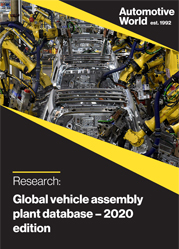According to a new report published by Automotive World, around 500 assembly plants globally produced 88 million cars, vans, trucks and buses in 2019.
Compared to the year before, the figure is notably lower; the decline was anticipated, and reflects a market in flux—but in a very different time.
Now, as automakers unlock factory gates after many weeks of closure, and explore the fastest and safest ways to restart production, the global automotive industry is only just starting to gauge the impact of lengthy unplanned production stoppages on annual output.
Production in 2020: from bad to…worst?
“With some market volumes falling to zero during COVID-19 lockdowns, it is clear that 2020 will see a severe drop in global output,” notes Jonathan Storey, who compiled the data for the latest edition of Automotive World’s ‘Global vehicle assembly plant database’. The annual study contains production data for nearly 60 vehicle groups, 140 brands and over 1,100 models, including light (<3.5t GVW) and heavy (>3.5t GVW) vehicles.
The 5% decline in global vehicle output from 2018 to 2019 will be dwarfed by the coronavirus-inflicted collapse in output in 2020, which could be anywhere between a conservative 15% and a devastating 25%
The inevitably sharp decline in vehicle output in 2020 will occur against the backdrop of a record drop in global trade; according to the United Nations Conference on Trade and Development (UNCTAD), global trade will fall quarter-on-quarter by 27% in Q2. Citing data from the UN’s Committee for the Coordination of Statistical Activities (CCSA), UNCTAD states: “The coronavirus pandemic led to a 3% drop in global trade values in the first quarter of 2020. The downturn is expected to accelerate in the second quarter, according to UNCTAD forecasts, which project a quarter-on-quarter decline of 27%.” In March alone, notes the Geneva-headquartered UN body, commodity prices fell by a record 20%, which it attributes primarily to the steep drops in the price of oil as well as other commodities.
In 2018, the world’s vehicle manufacturers turned out just under 93 million units, and the 2019 data highlights falling demand for light vehicles in particular in a number of key markets that began in 2018. Indeed, UNCTAD had warned in September 2019 of a likely global recession in 2020 due to weakening demand in major markets and geopolitical uncertainty; however, UNCTAD notes in its Q2 2020 warning that, “Before the COVID-19 pandemic sent international commerce into a tailspin, global merchandise trade volumes and values were showing modest signs of recovery since late 2019.”
It’s all about liquidity
Nonetheless, the roughly 5% decline in global vehicle output from 2018 to 2019 will be dwarfed by the coronavirus-inflicted collapse in output in 2020, which Storey suggests could be anywhere between a conservative 15% and a devastating 25%.
As automakers look to conserve cash, they will make cuts across all areas of discretionary spending, including marketing and R&D. Cash outlay for capital projects will be stopped, slowed or postponed where possible
A key theme for analysts and commentators observing the automotive industry throughout the pandemic has been the importance of liquidity, and the need for automakers and suppliers to ensure their balance sheets are as strong as possible to dampen the impact of the coronavirus. “As automakers look to conserve cash, they will make cuts across all areas of discretionary spending, including marketing and R&D,” says Storey. “Cash outlay for capital projects will be stopped, slowed or postponed where possible.”
With automakers haemorrhaging cash as factories stood idle—Volkswagen is understood to have burned through around US$2.2bn a week without building any vehicles—credit lines have been lifelines, and it would be easy to suggest that any company desperate to preserve cash would react quickly by axing some of its weaker-performing manufacturing operations. However, Storey believes decisions on factory closures remain some way down the road. “We do not anticipate a wave of plant closures as an immediate response to the downturn—always assuming none of the major automakers goes under as a consequence of the pandemic.”
Plant closures, he notes, are not short-term decisions and the cash outlay for employee dismissals is significant. Furthermore, he adds, “automakers will not want to erode their core operations if industry demand is broadly expected to recover to pre-COVID-19 levels.”
The frantic search for cost-saving opportunities
As well as drawing down tens of billions of dollars’ worth of credit in an effort to boost liquidity to survive the pandemic, automakers have already begun exploring other cost saving opportunities, stalling or cancelling vehicle launches, delaying autonomous vehicle programmes and preparing major cost-cutting initiatives.
The question is, are sacred cows immune to COVID-19?
Significantly, however, even before the coronavirus pandemic, automakers were struggling to balance the need to show leadership in connected, autonomous, shared and electric (CASE) technology with the need to maintain profitability in the face of increasingly stringent emissions regulations and a shrinking market.
“Since the financial crisis, several automakers have shown a new readiness to slaughter sacred cows as they seek to gear their production networks to be profitable under the normal market cycles,” explains Storey. “GM has completely closed its operations in several regions, Honda is ending its European production and European automakers have shuttered plants, if not from A to Z, at least from Aulnay to Uddevalla. It is possible that COVID-19 will be cited as the proximate cause of a plant closure, but in all likelihood the pandemic will only represent the final nail in the coffin.” In such cases, notes Storey wryly, the question is, “Are sacred cows immune to COVID-19?”
Factory lights are being turned back on, production and assembly lines are being restarted, and the automotive industry’s long supply chains are being revived. The latest edition of Automotive World’s ‘Global vehicle assembly plant database’ shows clearly how the global automotive industry looked at the start of 2020; how it will look at the end of 2020 will be decided by the coronavirus—and by the recovery strategies conceived in the automakers’ executive boardrooms.




